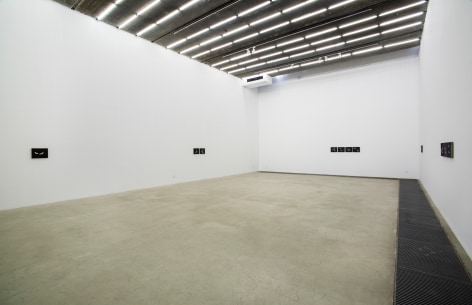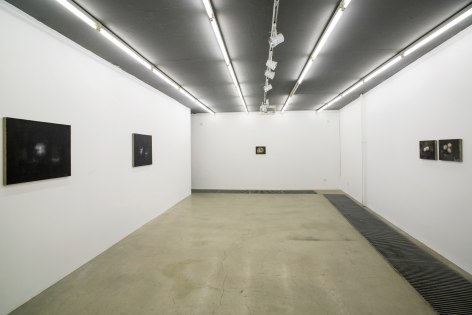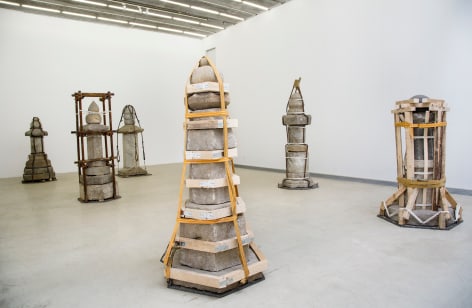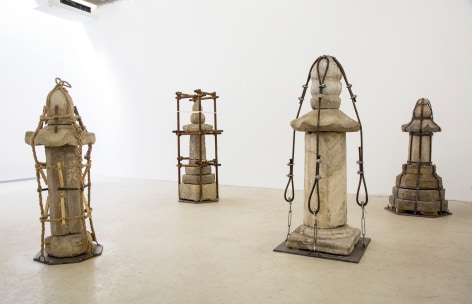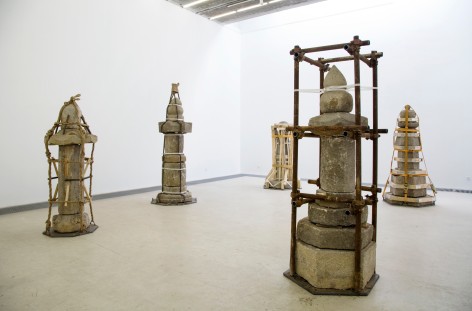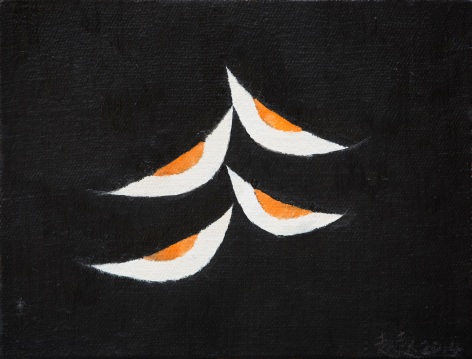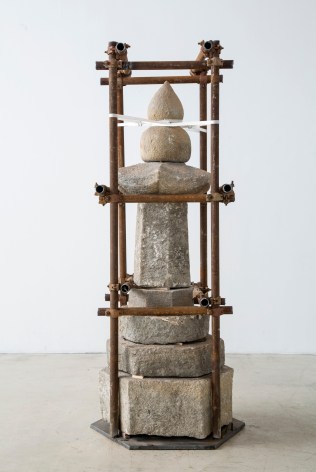Chambers Fine Art is pleased to announce the opening on May 24, 2014 of Zhao Zhao: Uncertainty. For his third exhibition at Chambers Fine Art Zhao will present two groups of works, paintings of preserved duck eggs and an installation utilizing Buddhist stupas dating from the Ming dynasty and earlier. Although Zhao Zhao adheres rigorously to his credo of never repeating himself, his diverse body of work is united by an attitude that might be described as simultaneously irreverent and respectful of the past.
Zhao Zhao has gained a certain notoriety through the critical edge of his early objects and the political aspects of his magnum opus so far, the monumental 2011 sculpture Officer. At the same time he has produced works such as Again, 2012, exhibited at the Ullens Center for Contemporary Art (UCCA), that show a deep respect for aspects of traditional Chinese religion and culture, however drastic the measures he takes to preserve them might seem.
Again, now part of the Ullens’ permanent collection, is a large cubic form made from blocks of stone carved from fragmentary Buddhist sculptures from which the remaining projecting parts have been cut off. However, this monumental stone cube resembles other works of minimal sculpture only in its superficial aspects.
In contrast, the Buddhist stone stupas that Zhao Zhao has gathered in Uncertainty are presented in essentially unmodified form although the separate stones that are piled on top of each other require external support in the form of metal scaffolding, wooden beams, rebar, rope etc. to prevent them from toppling over. For Zhao Zhao these deeply symbolic forms, propped up and rather forlorn in their new context, find parallels in Chinese society today in which uncertainty has replaced the philosophical, religious and even political certainties that used to prevail. Removed from their original settings and displayed in such a precarious condition, the stupas have been drained of their ability to inspire quiet meditation, although the beauty of their forms and the powerful response they evoke in the viewer is equally as profound.
In complete contrast to the stupas, in a new series of intimate paintings Zhao Zhao takes as his theme the duck eggs salted in brine or damp salted charcoal that are a favorite Chinese foodstuff. As with many aspects of life in China, these humble eggs have a long provenance, records for preparing them having been found dating from the Han dynasty (206 BC – 220 AD). In addition, the deep orange - red color of the yolks makes them perfect symbols for the moon in Chinese moon-cakes.
However, Zhao Zhao wears his learning lightly and the sequence of small paintings in which slices of salted duck egg float on an inky black background is endearingly absurd. Here another kind of uncertainty prevails, speculation as to the meaning of this unexpected presentation of a frequently encountered delicacy that is consumed without thinking. In the rush to modernity, the superficial pleasures of consumerism have resulted in mindless destruction and heedless forgetfulness of more traditional values and ways of thinking.
As the visitor moved between the gallery of salted duck eggs and the forest of stupas, the impressions formed and questions raised in one gallery inevitably affect his/her experience in the other. There is a riddle to be solved, it seems, but it is up to the visitor to find the answer! The artist can only point the way.
前波画廊于2014年5月24日举办《赵赵:不安》的开幕展。此次展览是他在前波画廊的第三次个展,并由两组作品组成:以咸鸭蛋为主题的油画和利用明清时期佛塔做的雕塑装置。虽然赵赵一直坚持拒绝重复的原则,但是他的多元化的作品却始终贯穿着对往昔既不敬又尊重的态度。
赵赵早期极具批判性的作品和蕴含鲜明政治色彩的杰作,例如2011年的雕塑作品《伟像》,令他“恶名昭著”。与此同时,赵赵在2012年创作并在尤伦斯当代艺术中心展出的作品《重复》;无论他采用的表现手法有多么激进,该作品彰显了他对中国传统宗教和文化的深深敬意。
《重复》是由若干石块组成的巨型立方结构,现在已成为尤伦斯的永久收藏作品。这些石块原本都是佛像雕塑的残片,雕塑的凸形部分已经被截掉。虽然类似于别的极简雕塑作品,但是赵赵的巨型石雕和它们的相似之处仅停留在表面。
于极简艺术恰恰相反,除了将石块用金属架,木头,钢筋,绳索等进行外部固定以防止倒塌之外,在《不安》展览中的佛塔基本未经过任何修改。对于赵赵而言,这种象征意义的形态在新的语境里恰好折射了中国社会现实——原先哲学、宗教甚至政治的确定性已被今天的“不安”所取代。脱离了原始环境并被置放于如此空洞氛围里的佛塔,尽管它的美感仍能激发观者强烈的共鸣,其唤起人们顶礼膜拜的力量却已荡然无存。
与佛塔形成鲜明反差, 赵赵的油画系列从食材咸鸭蛋中摄取灵感。正如中国人生活的许多方面,广受欢迎却不起眼的咸鸭蛋有着悠久和丰富的历史。史书上记载,制作咸鸭蛋的工艺可追溯到汉代 (公元前206–220)。 与此同时,咸鸭蛋的蛋黄色泽红润,令它们成为中国月饼中象征完美的月亮。
然而,赵赵并不局限于阐诠传统文化。在一系列小型画作中,一瓣瓣的咸鸭蛋漂浮于墨黑般的背景上。这种阐释手法既荒诞,又惹人喜爱,而这里又蔓延开来另一种“不安”。我们常会食用到咸鸭蛋,却从未对它进行过太多的关注和思考。这种意外的展现方式让观者不禁揣测它的意味。人们仓促地追求现代化,被消费主义带来的的肤浅愉悦感所麻木。这一现象造成越来越多的传统价值和思考方式被人们无知地摧毁以及无意识地淡忘。
在漂浮的咸鸭蛋和“佛塔林”两个空间中来回穿梭,访客们在一个展厅中产生的印象和疑问不可避免地影响其对另一个展厅的体验。这种感受似乎是一个未解之谜,而答案只能由观者自己寻找,艺术家能做的只是指出一条路。

